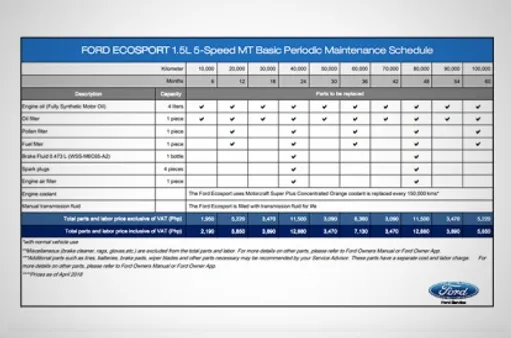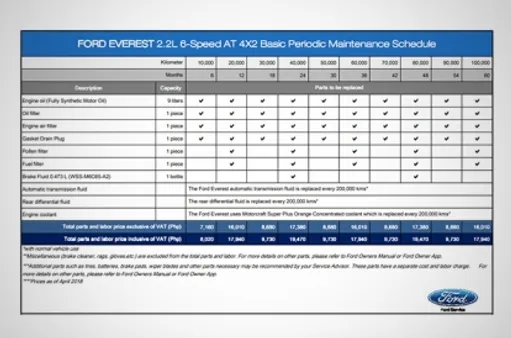Table of Contents
As a Ford Everest owner, ensuring your vehicle receives proper maintenance is crucial for its longevity and optimal performance. This comprehensive Maintenance Checklist for Ford Everest Owners provides a detailed guide to all the essential maintenance tasks you need to perform, ensuring your Everest runs smoothly for years to come. Whether you're a seasoned DIY enthusiast or prefer professional assistance, this checklist empowers you with the knowledge to make informed decisions about your vehicle's maintenance. Trust Westernfordhcm for all your Ford Everest servicing needs and experience the peace of mind that comes from knowing your vehicle is in hands.
|
Maintenance Checklist for Ford Everest Owners
| |:---|:---| |**Interval**|* **Tasks**| |**Every 15,000 Kilometers or 12 months**|* Oil and filter change * Tire rotation * Brake inspection * Fluid level check * Battery inspection| |**Every 30,000 Kilometers or 24 months**|* Transmission fluid change * Differential fluid change * Spark plug replacement * Air filter replacement * Cabin air filter replacement| |**Every 45,000 Kilometers or 36 months**|* Timing belt replacement * Water pump replacement * Fuel filter replacement * Coolant flush * Brake fluid flush| |**Every 60,000 Kilometers or 48 months**|* Major service * All fluids changed * All filters replaced * Comprehensive inspection|
I. Maintenance Checklist for Ford Everest Owners: Essential Checks for Optimal Performance
Regular Inspections:
- Tire pressure and tread
- Fluid levels (oil, coolant, brake fluid, windshield washer fluid)
- Headlights, taillights, and turn signals
- Brake pads and rotors
- Battery
Every 15,000 Kilometers or 12 Months:
- Oil and Filter Change
- Rotate Tires
- Check Brake Inspect
- Fluid Level Check
- Battery Inspection
Every 30,000 Kilometers or 24 Months:
- Transmission Fluid Change
- Differential Fluid Change
- Spark Plug Replacement
- Air Filter Replacement
- Cabin Air Filter Replacement
Every 45,000 Kilometers or 36 Months:
- Timing Belt Replacement
- Water Pump Replacement
- Fuel Filter Replacement
- Coolant Flush
- Brake Fluid Flush
Every 60,000 Kilometers or 48 Months:
- Major Service
- All Fluids Changed
- All Filters Replaced
- Comprehensive Inspection
Additional Tips:
- Stay informed about any recall notices or manufacturer recommendations specific to your Ford Everest year and model. Explore off-roading adventures to unleash your Everest's full potential while prioritizing safety.
II. Regular Maintenance Schedule: A Comprehensive Guide for Ford Everest Owners
As a Ford Everest owner, adhering to a regular maintenance schedule is crucial for ensuring optimal performance, longevity, and safety. This comprehensive guide provides a detailed overview of the essential maintenance tasks you need to perform at specific intervals to keep your Everest running smoothly.
Refer to your vehicle's owner's manual for specific maintenance intervals and consult with a qualified mechanic for any complex repairs or services.
Every 15,000 Kilometers or 12 months
- Oil and filter change
- Tire rotation
- Brake inspection
- Fluid level check
- Battery inspection
Every 30,000 Kilometers or 24 months
- Transmission fluid change
- Differential fluid change
- Spark plug replacement
- Air filter replacement
- Cabin air filter replacement
Every 45,000 Kilometers or 36 months
- Timing belt replacement
- Water pump replacement
- Fuel filter replacement
- Coolant flush
- Brake fluid flush
Every 60,000 Kilometers or 48 months
- Major service
- All fluids changed
- All filters replaced
- Comprehensive inspection
By following this maintenance schedule, you can help extend the lifespan of your Ford Everest, enhance its performance, and ensure a safe and enjoyable driving experience. Remember to consult your owner's manual for specific details and seek professional assistance when necessary.
For more information on Ford Everest maintenance, check out our related posts:
- Maintenance Costs and Budgeting for Ford Everest Ownership
- DIY Maintenance: Changing Oil
- DIY Maintenance: Changing Filters

Regular Maintenance Schedule: A Comprehensive Guide for Ford Everest Owners
III. DIY Maintenance Tips: Empowering Ford Everest Owners with Essential Knowledge
Empowering Ford Everest Owners with Essential Maintenance Knowledge
As a Ford Everest owner, taking proactive steps to maintain your vehicle is crucial for its longevity and optimal performance. By performing regular maintenance tasks, you can identify and address potential issues early on, preventing costly repairs and ensuring a smooth driving experience. This guide provides a comprehensive overview of essential DIY maintenance tips, empowering you with the knowledge and confidence to keep your Everest running at its best.
Before embarking on any DIY maintenance, it's essential to consult your vehicle's owner's manual for specific instructions and safety precautions. Additionally, if you encounter any complex tasks or require specialized tools, do not hesitate to seek assistance from a qualified mechanic.
Routine Maintenance Tasks for Ford Everest Owners
Regular maintenance is the cornerstone of vehicle longevity. By adhering to the recommended maintenance schedule, you can proactively address potential issues and extend the lifespan of your Ford Everest. Here's a breakdown of routine maintenance tasks based on mileage or time intervals:
Interval | Tasks |
|---|---|
Every 15,000 Kilometers or 12 months |
|
Every 30,000 Kilometers or 24 months |
|
Every 45,000 Kilometers or 36 months |
|
Every 60,000 Kilometers or 48 months |
|
Who should service your Ford Everest?
When it comes to servicing your Ford Everest, you have two main options: DIY maintenance or professional assistance. While DIY maintenance can save you money in the short term, it requires a certain level of mechanical knowledge and ise. If you're not comfortable performing maintenance tasks yourself, it's best to entrust your vehicle to a qualified mechanic.
Professional mechanics have the training, experience, and specialized tools to handle complex maintenance and repairs. They can also provide valuable advice on maintaining your vehicle and keeping it in top condition. However, professional servicing can be more expensive than DIY maintenance.
Ultimately, the decision of whether to perform DIY maintenance or seek professional assistance depends on your individual circumstances, skills, and budget. If you're confident in your abilities and have the necessary tools, DIY maintenance can be a cost-effective way to keep your Ford Everest running smoothly. However, if you prefer peace of mind and care, professional servicing is the recommended choice.

DIY Maintenance Tips: Empowering Ford Everest Owners with Essential Knowledge
IV. Troubleshooting Common Issues: A Practical Guide for Ford Everest Owners
Engine-Related Issues
Problem: Engine won't start.
Solution: Check the battery, alternator, and starter. Clean or replace as necessary.
- Check battery terminals for corrosion.
- Inspect alternator belt for wear and tension.
- Test starter solenoid and motor for proper function.
Problem: Engine stalls while driving.
Solution: Check the fuel filter, fuel pump, and fuel pressure regulator. Clean or replace as necessary.
- Replace fuel filter every 15,000 kilometers.
- Inspect fuel pump for proper operation and pressure.
- Test fuel pressure regulator for leaks or blockages.
Electrical Issues
Problem: Headlights or taillights not working.
Solution: Check the bulbs, fuses, and wiring. Replace or repair as necessary.
- Inspect bulbs for burnt filaments.
- Check fuses for blown elements.
- Trace wiring for breaks or shorts.
Problem: Dashboard warning lights staying on.
Solution: Check the corresponding sensors and systems. Diagnose and repair the underlying issue.
- Use OBD-II reader to retrieve diagnostic codes.
- Inspect sensors for cleanliness and proper connection.
- Test system components for functionality and leaks.
Suspension and Steering Issues
Problem: Vehicle pulls to one side while driving.
Solution: Align the wheels and check the suspension components.
- Adjust wheel alignment to manufacturer's specifications.
- Inspect suspension components for wear or damage.
- Replace worn or damaged suspension parts.
Problem: Steering wheel vibrates at highway speeds.
Solution: Balance and rotate the tires. Check for suspension or steering component issues.
- Balance tires to ensure even weight distribution.
- Rotate tires to promote even wear and extend lifespan.
- Inspect steering components for loose or worn parts.
V. Conclusion
By following the maintenance schedule outlined in this checklist, you can ensure that your Ford Everest receives the care it needs to perform at its best. Regular maintenance not only extends the lifespan of your vehicle but also enhances its safety, reliability, and fuel efficiency. Remember, a well-maintained Ford Everest is a happy Ford Everest. If you have any questions or concerns about your vehicle's maintenance, don't hesitate to consult your trusted mechanic or visit westernfordhcm for advice and service.